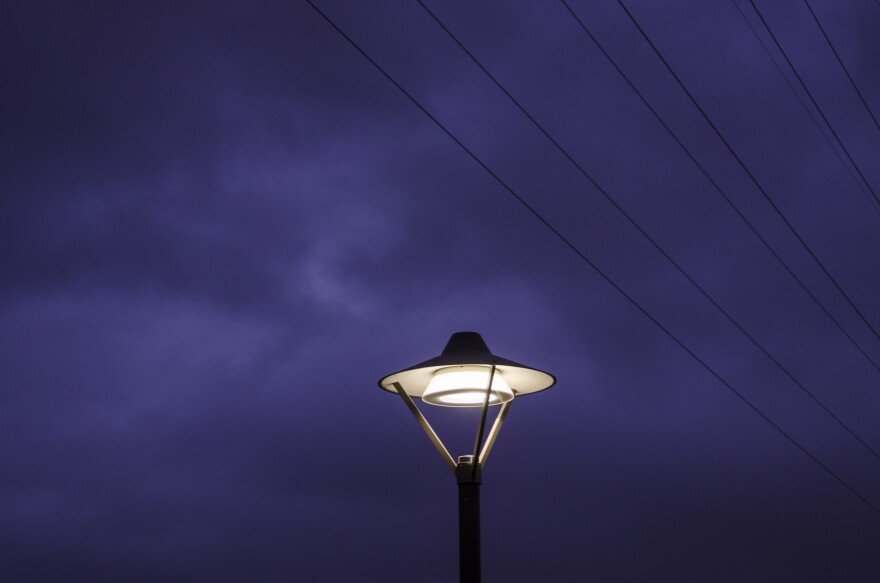When the Arch grounds renovations are complete in spring 2017, the site will boast a new museum, new walking paths and new access points from downtown.
It will also include several fascinating design elements from the Arch's past that visitors might walk by without noticing - or not be able to see in the first place.
Ahead of the Arch's 50th anniversary, St. Louis Public Radio sat down with Ryan McClure, CityArchRiver communications director, to learn more about what eagle-eyed Arch-goers will see.
"There are so many things that are built into this that visitors may notice at some point, but they won't get a lot of attention." -CityArchRiver's Ryan McClure
Saarinen-inspired light fixtures

According to McClure, CityArchRiver designers found an old sketch book featuring Arch's designer EeroSaarinen's vision for light fixtures that would dot the original Arch grounds. These mid-century modern designs, which McClure said looked kind of like "flying saucers," were never realized; instead lollipop-shaped lighting was installed. But the designers of the new renovation have been inspired by the original sketches to create new energy efficient lighting for the processional walkways leading to the Arch from the north and south.
"So our designers took that idea that Saarinen had...and we're able to implement something that hearkens back to his design on the Arch grounds." -CityArchRiver's Ryan McClure
The façade of The Old Rock House

The Old Rock House was originally built as a trading post warehouse on the riverfront in 1818 by early St. Louis settler and fur trader Manuel Lisa. Later purchased by a cousin of Mark Twain, the building would go on to house shops, a saloon of ill-repute and eventually a somewhat respectable establishment.

As plans to create the Jefferson National Expansion Memorial got underway in the 1930s, local efforts were made to save the building, and at one point McClure said it and the Old Cathedral were "the only buildings left standing from the original riverfront." But the house met its end in the 1940s, its tenants evicted and the building demolished, as the National Park Service cleared the future Arch grounds. Plans to reconstruct the building for a museum were later scrapped.
Luckily, McClure said the National Park Service kept a lot of the Old Rock House's stones and will incorporate these pieces of history into the new Arch museum. As visitors pass from one themed section of the museum (called a "story zone") to another, they'll literally walk through the reconstructed façade of this historic building.
The statue of Thomas Jefferson

Those who remember the original "Museum of Westward Expansion" will recall that right near the entrance, past the big taxidermy bear, was a statue of Thomas Jefferson, gazing westward. The new Arch museum removes Jefferson from his former prominent position, but the Founding Father won't go far. The statue will now be displayed in a story zone dedicated to Jefferson's vision of westward expansion.
Cobblestones and a less-grand Grand Staircase


Part of the Arch grounds renovations involve elevating Leonor K. Sullivan Boulevard 2.5 feet between Chouteau and Biddle to reduce routine flooding that closes off riverfront access during peak tourism season, McClure said. While raising the road will reduce flooding incidents by 60 percent, it also means sacrificing five steps of the Grand Staircase.
The elevation construction also called for the removal of some of the cobblestones on the levee below the riverfront promenade and the Grand Staircase. But they will be reused in the new design to divide expanded pedestrian and bicycling pathways along the riverfront.
Unseen cisterns

Under the new Luther Ely Smith Square, between the Old Courthouse and the Arch Grounds, will be two underground cisterns that can house 65,000 gallons of water. Though visitors won't be able to see the cisterns, these "cool, sustainable" features will drain and filter stormwater that will then be used to irrigate the park and Arch grounds, McClure said. Another set of cisterns will be installed under downtown's Kiener Plaza, after construction begins in December.
Follow Stephanie Lecci on Twitter: @stephlecci



